OFF THE CUFF….
Little known facts about the
legendary Chetan Anand from son Ketan…
He sits contemplating the sky and the ocean in his home, known
affectionately as `The Shack’, on Juhu Beach; rum glass in hand. This is Ketan
Anand, son of the legendary film maker Chetan Anand, a film director
himself (Toote
Khilone, Hum Rahe Na Hum, Shart, Aaja Meri Jaan, Chetan Anand: The Poetics of Film,
TV serials Vijay & Paramveer Chakra) and my cousin! Popular as
`Kunkie’ and `Kunks’ in the family and the film fraternity, he is also my
brother Shekhar’s best friend and confidant. Whenever Shekhar is low, he
“toodles across” to share a rum and complain about the nasty world
to him, he tells me. Kunkie is without doubt a hot favourite with the
family. Oh, and he’s an actor too, having made appearances in Dev Anand’s Hare Rama Hare Krishna, Chetan
Anand’s Heer
Ranjha, Johnny Bakshi’s Raavan, Amit
Khanna’s Sheeshay
Ka Ghar and an Indo-French film, Hexing, which
has been released on Amazon Prime in the U.S. and U.K. and is awaiting release
on an Indian OTT platform.
So when I approach him for some unknown facts about his
illustrious father, he raises his glass and cheers us with his customary
“Habba, Dabba Doo” greeting. He does look somewhat of a magician, with
his white beard and hair, dark glasses and hat.
I want to know about the little known facts about uncle Chetan,
I repeat. “Well, he was an innovative film maker and nobody knew that better
than his contemporaries”, replies Kunkie, swirling his drink around in an
absent- minded fashion. That’s an Anand trademark. The eyes and mind are
elsewhere even if one is talking to them. Some find it endearing while others
get upset. But I am family so I have learnt to put up with it. By being
annoyingly persistent.
“And….?”
“Satyajit Ray, for example, he was a young copywriter in an ad
agency then. And he saw dad’s first film, Neecha Nagar, which
was made in 1945. He said the film had such an impact on him that he decided to
switch professions after that and become a film maker. It was a big compliment
to dad. Ray also liked the idea of the film’s music being composed by classical
musicians like Ravi Shankar and Ali Akbar Khan. Thereafter, Ray
made Pather Panchali and got them to compose the music for his
Apu Trilogy. Also not known is that the heroine’s role was offered to my ma,
Uma Anand, who was also Neecha Nagar’s heroine. She politely
declined saying she didn’t want to pursue a solo profession since she had a
young family to look after and that she was very happy with her job as a
newsreader with AIR. Ray and dad shared a warm friendship and mutual
admiration”.
“ In another incident, while he was attending an international
film festival (he attended many of those) the famous Hollywood director
Vittorio de Sica (Bicycle Thieves, Marriage Italian Style, Yesterday,
Today & Tomorrow) came up to dad and pointed out a montage
in Neecha Nagar that he wanted to copy. The sequence was
a brilliant series of images juxtaposed with each other with Ravi Shankar and
Ali Akbar Khan’s music in the background. The film is about how the poor people
of Neecha Nagar (Lower City) are deprived of water by the upper classes of
Ooncha Nagar (Upper City), by diverting its sources to their own colonies. An
impoverished child is futilely sucking the end of a dry tap, while people rise
in rebellion, chanting `Pani, Pani!’ Ravi Shankar’s sitar picks up
the human note and fans it out into a symphony, leading to the grand finale of
the film. Well, Sica loved it and dad, happy with the compliment, gave him
permission to use the technique in one of his films, I forget which.”
Neecha Nagar was a landmark film.
“ It was the only Indian entry at Cannes in 1946. Those days they did not have the Palme d’Or , but it’s predecessor, The Grand Prix. And Neecha Nagar won it along with some top ranking films, including Brief Encounter by David Lean. “
The rum has done its work. Kunkie is out of his reverie and
eloquent now.
“My dad, along with K.A. Abbas, who wrote the dialogues
for Neecha Nagar, paved the way for realistic cinema. At that
time mythologies were popular in India. I would love to remake Neecha
Nagar. It’s a universal theme that can work in any era. In fact the
Korean film Parasite, that won the Oscar last year, has the
same story. Upper house, lower house, deprivation of water. (Speculatively)…
Wonder where he got the story from….? And Shekhar’s Paani, which
never got made, was based on Neecha Nagar but was
futuristic. His idea was that the fight over land today will turn into the
fight for water in the future, as sources dry up.
The print of Neecha Nagar was lost and was
discovered by chance, right? A very lucky discovery for our film archives!
“Yes, yes. The lab where this print was, caught fire. I think it
was a Tardeo lab. Subsequently, Satyajit Ray’s cameraman was rummaging through
a kabadi wala’s stuff and saw negatives of a film in the
rubbish. When he checked it, it turned out to be Neecha Nagar’s
print! He thought, good god, this is an award winning film! So he bought that
film for 100 rupees from the kabadi wala and presented it to
the Poona Archives. The Archives made subtitled prints of it and got in touch
with dad. They gave him a print too. So now we have DVDs of it. Whenever
there is a festival anywhere in the world, the Archives ask our permission and
send it directly to the festival. Or, if someone asks me, I forward a letter to
the Archives and they send it.
Oh and uncle also worked as an actor…
“Yes, in Anjali, which he directed and Kala
Bazaar which younger brother Goldie (Vijay Anand) directed. In fact
, Kala Bazaar is perhaps the only film in which all three
brothers acted. Aha, but he also got a juicy offer from a Hollywood biggie,
Walter Lang (The King & I, There’s No Business Like Show
Business, Can Can)! who was preparing for his opus The King &
I. He had met dad before and offered him the lead role! Dad, by then,
had decided to be a director so he declined the offer. Lang was persistent. He
said dad had the face that he wanted for the role, but dad was adamant. And
so Yul Brynner, a theatre actor, got the role and thereby hangs a tale! He
became a huge star after that blockbuster…what a film!”
Wow. So how did the two uncles, Dev & Chetan start Navketan
together? ( Incidentally, Navketan was named after Ketan).
“Well, Dev, who was already a star, having delivered hits with
the reigning queen, Suraiya. Dad was negotiating with some people to start a
film company, when uncle Dev came along and said “Bhaiji, why do
you want to leave the family? We’ll start our own banner and promote
ourselves.” And so the initial funding was done by Mr. Dev Anand and Navketan
Films was born. Dad put in the content and creative work. They had a good
run together and then Goldie grew up and took over. Navketan became a platform
for new talent. Whether actors, writers, or cameramen. Guru Dutt, Vijay Anand,
Raj Khosla, Kamini Kaushal, Kalpana Kartik, Johnny Walker, Manmohan Krishan,
Mundi Burman, were all Navketan products. Poets, composers and lyricists
flocked there too. Dada (S.D. Burman) composed for most of their films.
Fali and Jal Mistry shot a number of their films. Although Binder Ratra was
initially their chief cameraman and was like family to them. Navketan went on
to discover Zeent Aman & Tina Munim too, but that was much after dad had
left the company. They were Dev Anand discoveries.
“Afsar, in 1949, was the first Navketan’s film. It
was based on the Russian playwright, Gogol’s play, The Inspector
General. It was translated into Hindi by dad. Dev saab, who
was also the producer, was a little upset because he wanted it to
be an epic, but dad shot it like the play it was.
“ Dev saab was Gurudutt’s best friend and told
dad that he had promised to give him a break as a director. And so,
Navketan’s next film was Baazi (1951). It was Guru Dutt’s
first film as director. The film set the tone for Dev saab’s future
style. That devil- may- care, romantic hero, with his caps, jackets and
scarves. They took that character out of one of Marlon Brando’s films, maybe The
Wild Ones. Guru Dutt liked that cocky look and it became Dev Anand’s
trademark style. After Baazi became a hit, mum got after dad
asking him to lay off his heavy subjects and “make one for Dev, who was cut out
for this kind of a character”. Dad agreed. She wrote the script, dad directed, Goldie wrote
the dialogues and out popped Taxi Driver in 1954… starring the newly married couple, Dev Anand and Kalpana Kartik. In fact the two got married on the sets, in Mehboob Studios. A true family enterprise! It was a big hit. Then the two brothers made the comedy Funtoosh, which
my mother wrote and it did fairly well. After that, the two started falling
apart because Dev saab’s style and stardom were taking off and dad
wanted to return to his issue based subjects.
“Dad left Navketan to make Haqueeqat in 1962, under
his new banner, Himalaya Films. He was funded for the film by the Punjab
government. Subsequently he made Aakhri Khat, Rajesh Khanna’s first
release. He made his mark as an actor in this film, before he made his mark as
a star. Again, the storyline was unusual. A man goes in search of his little
son who is missing and after the entire nerve wracking search, finds him
walking into his house! The role was played by the adorable three- year -old
Bunty. Dad just let him loose on the streets of Mumbai and followed him around
with a camera! The result was heart warming shots of the toddler. But the one
who stood out was the new hero, Rajesh Khanna. The climax that he has performed
for 700 feet of film without a dialogue, is almost unique in the world! He had
to display multiple emotions when he sees the little fellow walk up to him in
his own house, after he has searched the entire city for him. Dad really ragdoed Kaka
(Rajesh Khanna) for that. He did not allow him to sleep for three nights,
didn’t allow him to shave and made him booze so much that he had a perpetual
hangover! That is what the scene demanded. Dad kept rolling the camera…and wow!
What a shot Kaka gave!! Amazing!
Kaka picked up a lot of his acting skills from
Chetan Saab, which he used in his later films. He copied Dev
and Dilip in some mannerisms, but in the dramatic scenes he emulated dad,
because dad was a dramatic film director. Then he developed his own style
because Kaka was Kaka. He was very innovative.
What he didn’t mention and what I found on the net was something
the entire family can be proud of. The Government of India issued a stamp on
Chetan Anand in 2013, when they were celebrating 100 years of Indian cinema.
Kunkie, the blue blood, now wants to retire for the evening.
Soaking in nostalgia has taken its toll and he `toodles off’ happily in
the direction of his room.
Ketan has paid his tribute to his dad by writing a book on him
with his mum, Uma, appropriately titled, Chetan Anand: The Poetics of
Film. He also made a film based on the book, anchored by the late Tom Alter .








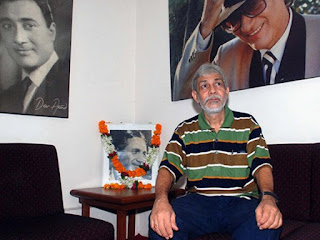







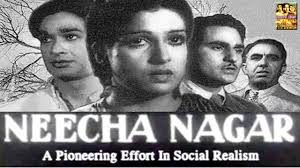




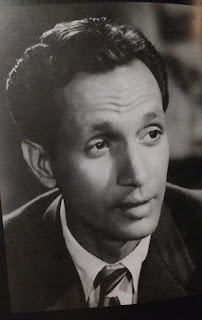

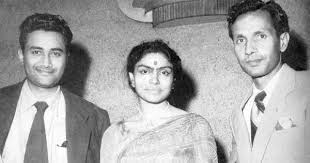
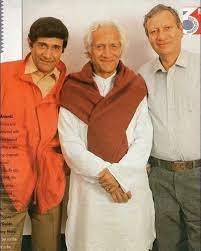














This was a lovely trip down memory Lane. Uma was my Masi you know and so Kunks is my cujjin too.
ReplyDeleteYes m dear and that makes u my cujjin too!
DeleteLovely nuggets of information about the family, and specially Uncle Chetan, who was so reserved he never talked about himself! It's an eye opener that he'd achieved so much
ReplyDelete